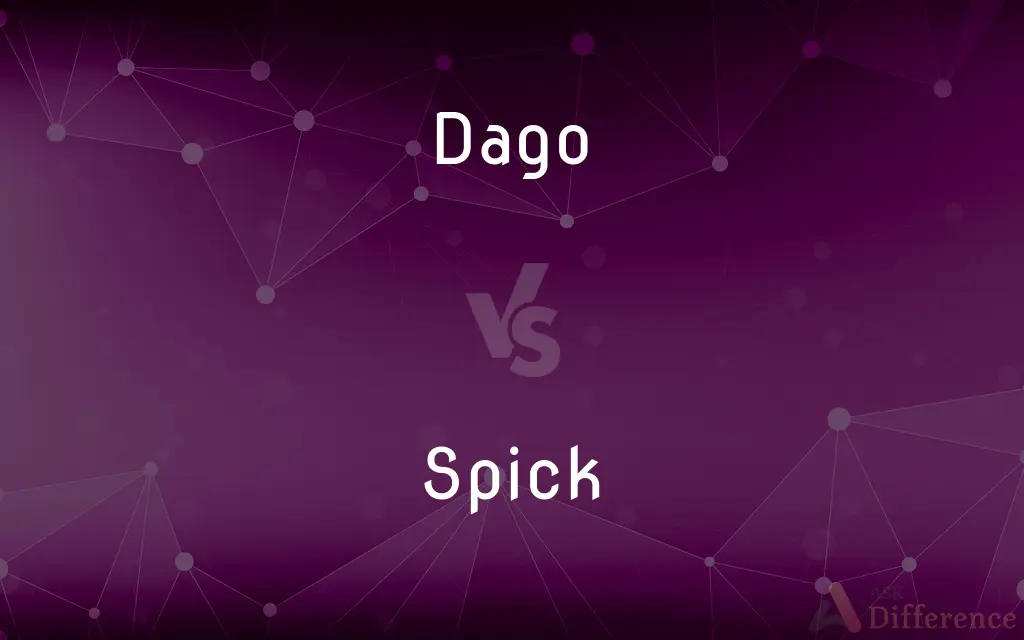Dago vs. Spick — What's the Difference?
Edited by Tayyaba Rehman — By Urooj Arif — Updated on April 21, 2024
Dago and Spick are both derogatory terms used in English, targeting Italian and Hispanic individuals respectively, reflecting cultural biases and ethnic slurs.

Difference Between Dago and Spick
Table of Contents
ADVERTISEMENT
Key Differences
Dago is an ethnic slur historically used in the United States and other English-speaking countries to disparage people of Italian descent. Whereas Spick (or spic) is similarly derogatory but aimed towards people from Spanish-speaking countries, particularly those from Central and South America.
The use of the term Dago can be traced back to the 19th century, derived possibly from the Spanish name "Diego" or as a contraction of "day-goer." On the other hand, Spick's origins are less clear but might have emerged from the mispronunciation or shortening of "Hispanic" or derogatory terms like "no spik English."
Dago was prominently used during periods of significant Italian immigration to the U.S., used to stereotype Italians as lower-class laborers. In contrast, Spick gained prominence as immigration from Latin American countries increased, used to stereotype and marginalize Spanish speakers.
Both terms have been widely criticized and are considered highly offensive. They reflect the xenophobic attitudes and discrimination faced by immigrants and ethnic minorities. While society's awareness and rejection of such terms have grown, they occasionally still appear in discriminatory speech or as references in historical contexts.
Understanding the harmful impact of these words is crucial for addressing racial and ethnic discrimination. Although both terms are offensive, the specific ethnic groups they target and their historical contexts differ, underscoring the diverse nature of racial slurs in the English language.
ADVERTISEMENT
Comparison Chart
Target Ethnicity
Italian
Hispanic (Spanish-speaking individuals)
Origin of the Term
Possibly from "Diego" or "day-goer"
Possibly a corruption of "Hispanic"
Historical Context
Used during large Italian immigration
Emerged with increase in Latin American immigration
Common Usage Period
Late 19th to mid-20th century
Mid-20th century to present
Perception
Highly offensive
Highly offensive
Compare with Definitions
Dago
A derogatory term for someone of Italian descent.
The graffiti included the word Dago, an offensive slur.
Spick
Used to marginalize Spanish speakers.
The policy was criticized for indirectly supporting the use of slurs like Spick.
Dago
An ethnic slur reflecting anti-Italian bias.
Historical documents reveal the widespread use of Dago in the past.
Spick
A racial slur in modern usage.
The term Spick appears in debates about immigration laws.
Dago
Reflects xenophobic attitudes.
The term Dago was used to demean Italians as outsiders.
Spick
A derogatory term for a Hispanic person.
He was upset after being called a Spick at school.
Dago
An offensive stereotype term.
The character was unfairly labeled a Dago in the story.
Spick
Reflects anti-Hispanic sentiment.
The use of Spick in an argument was clearly racist.
Dago
Used historically in discriminatory contexts.
Signs saying No Dagos allowed were common in certain areas.
Spick
Tied to discrimination against immigrants.
Immigrants were often derogatorily referred to as Spicks.
Dago
Used as a disparaging term for a person of Italian, Spanish, or Portuguese descent.
Spick
Variant of spic.
Dago
A person of Italian, Spanish, Portuguese, Greek, or other Mediterranean descent.
Spick
(obsolete) nail, a spike (slender piece of wood or metal, used as a fastener).
Dago
A person of Italian descent.
Spick
Tidy; fresh
Dago
A nickname given to a person of Spanish (or, by extension, Portuguese or Italian) descent.
Spick
A spike or nail.
Dago
Offensive terms for a person of Italian descent
Spick
Offensive terms for persons of Latin American descent
Spick
Completely neat and clean;
The apartment was immaculate
In her immaculate white uniform
A spick-and-span kitchen
Their spic red-visored caps
Common Curiosities
What should someone do if called a Spick?
It's advisable to address the situation by reporting it to authorities if necessary and engaging in educational dialogue if safe to do so.
Why are terms like Dago and Spick offensive?
They perpetuate negative stereotypes and reflect historical racial discrimination.
Who does the term "Spick" target?
It targets people from Spanish-speaking, primarily Hispanic, backgrounds.
What is the origin of "Dago"?
It possibly comes from "Diego" or as an abbreviation of "day-goer."
What are the implications of using a term like Spick in the workplace?
Using such a term can lead to disciplinary action, including termination, due to its discriminatory nature.
Are there any legal repercussions for using slurs like Dago or Spick?
In some contexts, using such slurs can constitute hate speech or harassment, leading to legal consequences.
Can the term Dago ever be used positively?
No, it is always considered derogatory and offensive.
What can be done to reduce the use of ethnic slurs?
Education, cultural sensitivity training, and promoting inclusivity can help reduce the use of such terms.
Is Dago still commonly used today?
Its use has declined significantly due to increased awareness of its offensive nature.
How have communities reacted to these slurs historically?
Communities have often rallied against such slurs, advocating for respect and inclusion.
Can literature and art contribute to the understanding of the impact of such slurs?
Yes, they can reflect societal attitudes and the harm caused by such language, promoting a deeper understanding and empathy.
How does media portrayal affect the use of terms like Dago and Spick?
Media can either perpetuate these slurs through negative stereotypes or help combat their use by portraying individuals from these backgrounds positively.
What alternatives are there to using terms like Dago and Spick when referring to these ethnic groups?
Using proper terms like "Italian American" or "Hispanic" is respectful and appropriate.
How do educational institutions handle the use of these terms?
Schools and universities typically have policies against hate speech, including the use of such slurs.
What role do social movements play in the rejection of slurs like Dago and Spick?
Social movements play a crucial role in raising awareness and advocating for the eradication of racial slurs.
Share Your Discovery

Previous Comparison
Scoop vs. Scooper
Next Comparison
Individuality vs. IndividualismAuthor Spotlight
Written by
Urooj ArifUrooj is a skilled content writer at Ask Difference, known for her exceptional ability to simplify complex topics into engaging and informative content. With a passion for research and a flair for clear, concise writing, she consistently delivers articles that resonate with our diverse audience.
Edited by
Tayyaba RehmanTayyaba Rehman is a distinguished writer, currently serving as a primary contributor to askdifference.com. As a researcher in semantics and etymology, Tayyaba's passion for the complexity of languages and their distinctions has found a perfect home on the platform. Tayyaba delves into the intricacies of language, distinguishing between commonly confused words and phrases, thereby providing clarity for readers worldwide.















































